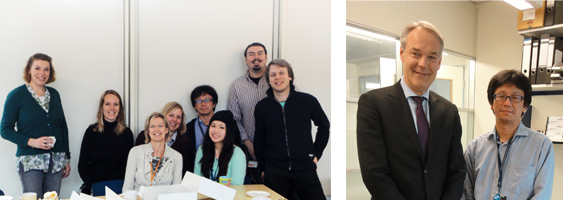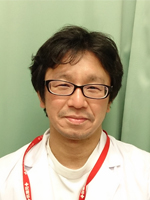EHA-JSH exchange program award general report
Kentaro Fukushima
Visiting researcher, Immunohematology and Blood transfuison, Leiden University Medical Center, the Netherlands
Dept. of Hematology and Oncology, Osaka University Graduate School of Medicine, Osaka, Japan
1) Problems about hematopoietic stem cell transplantation in Japan and Needs for a novel cell therapy
Currently, hematopoietic stem cell transplantation is performed as a curative treatment in blood diseases, especially acute myeloid leukemia, acute lymphoblastic leukemia and other hematological malignancies. During the transplantation procedure, graft versus host disease (GVHD) and graft failure are still important issues that affects the prognosis. Japan is considered to be relatively homogeneous in terms of HLA background, so the incidence of GVHD is likely to be mild compared to Europe or U.S. However, patients developing severe GVHD are not few and the disease is still lethal.
So I strongly believe novel strategies for treatment of GVHD will be needed also in Japan.
2) Mesenchymal Stem Cell, Basic research and clinical application
-From bench to bedside in Leiden University Medical Center-
I stayed Leiden, the Netherlands from January to March 2013 and studied basic science and clinical application of Mesenchymal Stem Cell (MSC), which is considered as a tool of novel cell therapy to manage post-transplant GVHD more effectively.
MSC is a heterogeneous cell population and the appropriate criteria for MSC are still being evaluated.
The International Society for Cellular Therapy (ISCT) defines MSC as follows;
MSC 1) are plastic-adherent when maintained in standard culture conditions, 2)
express CD105,CD73 and CD90, and lack expression of CD45, CD34, CD14 or CD11b, CD79a or C19 and HLA-DR surface molecules and 3) are able to differentiate towards osteoblasts, adipocytes and chondroblasts in vitro.
Additionally, MSCs have immunomodulatory capacities affecting a range of immunological cell types. Their effects are mediated through molecular factors a.o. IDO, PGE2, TGF-beta, HO-1, sHLA-G5 and anti-inflammatory cytokines like IL10,.
I have elaborated my knowledge on the properties of MSC and realized that MSC is an attractive source to manage GVHD. Nowadays, corticosteroids, calcineurin inhibitors, and some novel agents like mycofenolate mofetil(MMF), rabbit/horse anti-thymocyte globulin are widely used to prevent and treat GVHD, frequently unsuccesfully. MSC might be a valuable replacement or additive therapeutic option for patients with GvHD.
Leiden University Medical Center (LUMC) has a GMP facility (Good Manufacturing Practice), where clinical MSC products are generated from the human mononuclear cell fraction of bone marrow. I have learned the complete process of the production of MSC for treatment of GVHD, ulcerative colitis, chronic renal failure. The facilities are strictly controlled with respect to environmental and safety parameters, yet quite user-friendly and equipped with for example, cell culture benches, stock yards, corridor, patients data access.
In the laboratory, I have learned the actual method of MSC culturing and product analysis e.g. morphological analysis by microscopy, phenotypical analysis with flow-cytometry, quantitive measurement of cytokine concentration by ELISA and gene expressions using quantitive real time PCR.
I joined the weekly laboratory meetings where I used the opportunity to interact with all the members belonging to the lab of Dr. Fibbe and Dr. Staal. There were many discussion about research hypotheses, innovation of the method, consistency of the results which were very impressive. All the professors, researchers, technicians were friendly and I was able to discuss frankly about my questions, progress.
Additionally, LUMC seeks alternative tissue sources for MSC production since BM collection is associated with donor burden and health risks I believe that MSC production from fetus deposits like umbilical cord, placenta and amniotic fluid, containing a large amount of MSC, can have a great impact in the future.
Also, I had a chance to join a meeting in preparation of the upcoming multicenter randomized MSC trial for GvHD that is supported by HOVON (Dutch-Belgian Cooperative Trial Group for Hematology Oncology). I was much encouraged that clinical researchers not only from the Netherlands / Belgium but also from Italy, Spain, Germany, came around the table and discussed about common objectives. I realized that it is very important to unite and collaborate with doctors and researchers worldwide to establish new therapies.
3) My future directions in Japan
Now, back to Japan, I want to launch a similar system in Japan to produce MSC from human bone marrow and other alternative sources. Like in LUMC, I want to initiate not only basic research but also a translational research program with MSC, to aid patients who need cell therapy in Japan. Although MSC research is performed in many countries, many questions still remain regarding the nature of MSC, clinical efficacy and adverse effects. I aim to resolve them one by one in collaboration with researchers and clinicians in the LUMC and worldwide.
4) Acknowledgement
I would like to thank Prof. W.E.Fibbe, Prof. E.Staal, Prof.J.J.Zwaginga, Prof. Y.Kanakura, Prof. H.Roelofs and all members in the department of immunohematology and bloodtransfusion in LUMC. I also thank all staff members of EHA, JSH for selecting me as a laureate of the great awards. It was a great opportunity to understand the leading edge of cell therapy, sincerity for basic science and open-minded culture in the Netherlands, Europe.


